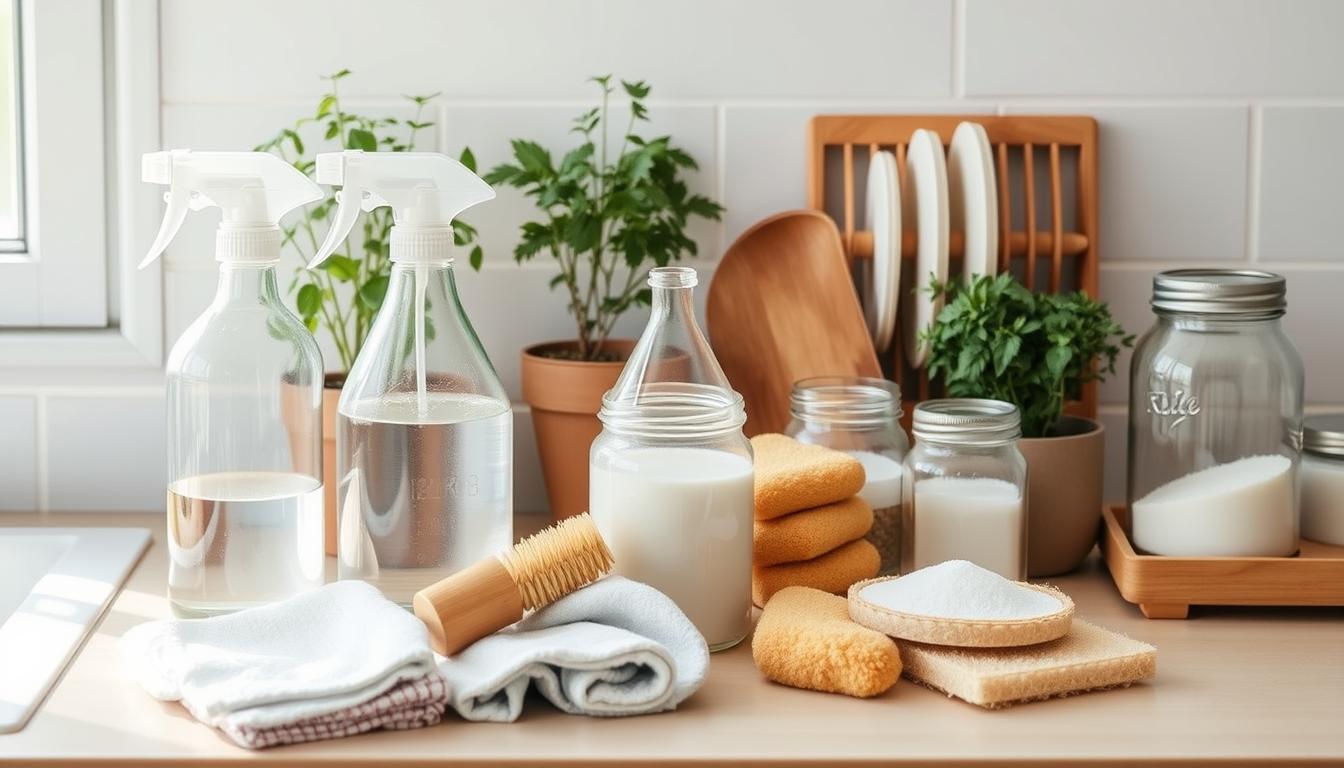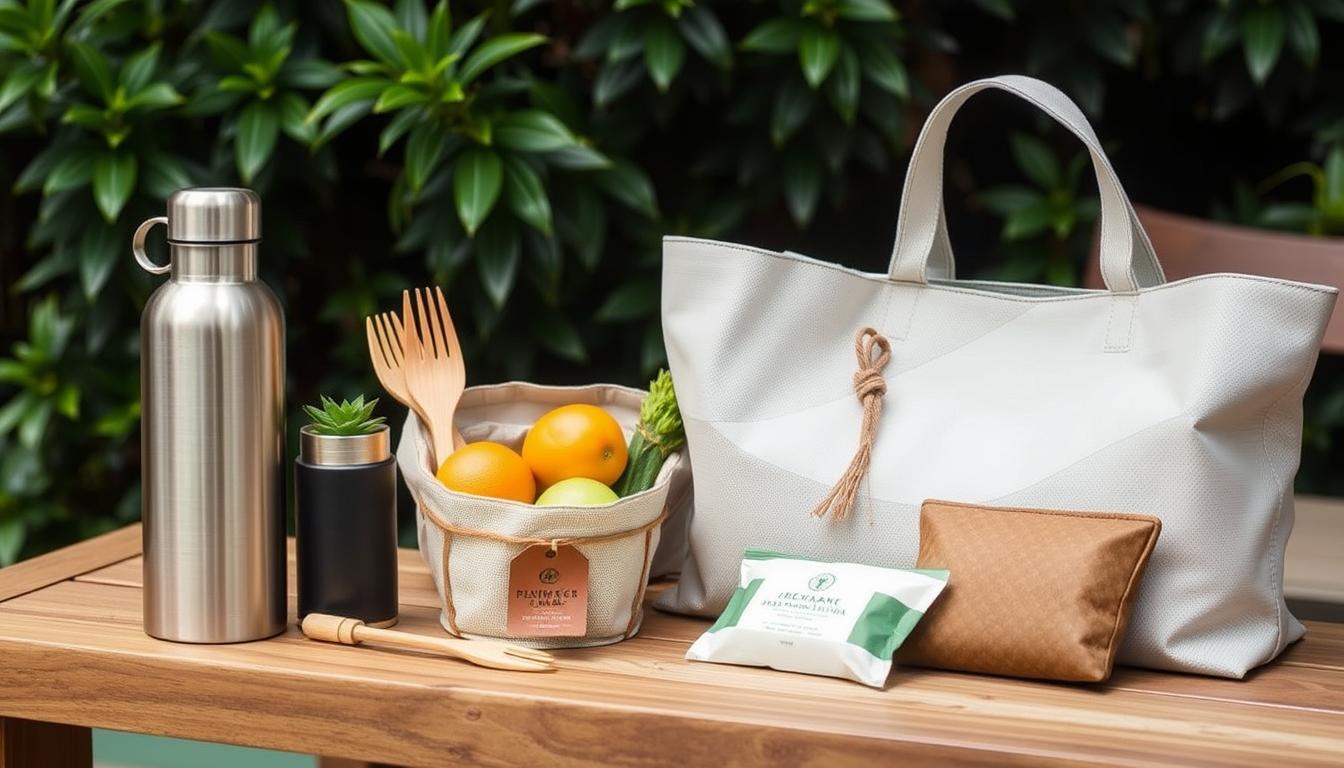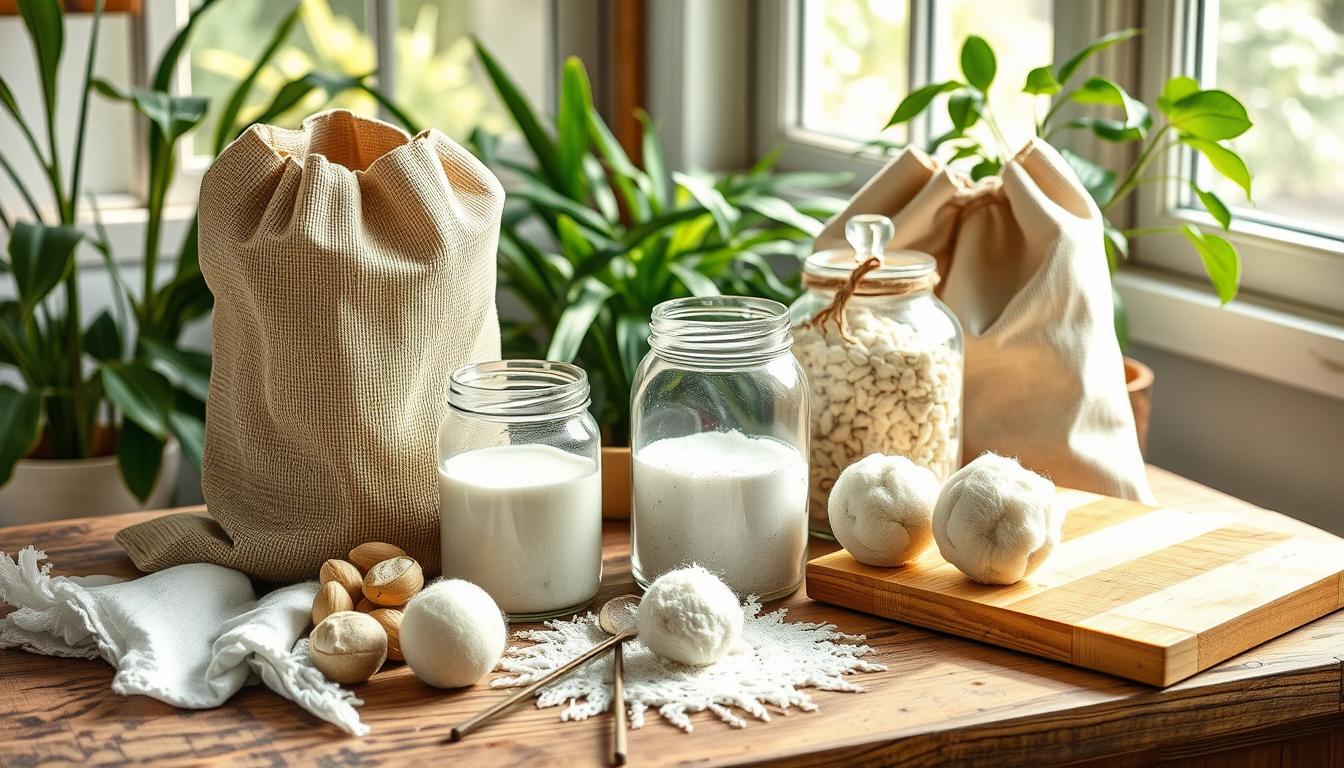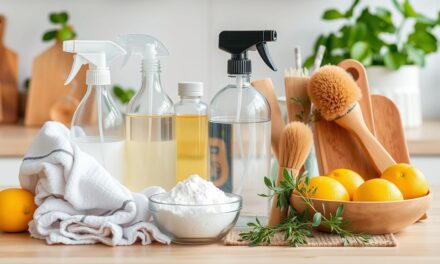Did you know the average person in developed countries throws away up to 4.5 pounds of waste daily? This shows how urgent it is to adopt sustainable living and use zero-waste products. These can greatly lessen our harm to the environment.
Starting a zero-waste lifestyle isn’t about being perfect. It’s about choosing smart, eco-friendly options that save money and the planet. Thanks to new products, living sustainably is now easier and cheaper. You can cut your waste by 50-80% with these changes.
Using reusable mugs can stop 167 disposable cups from being thrown away each year. Cloth bags can prevent 500 single-use plastic bags from being used. These small changes can make a big difference. Plus, you don’t have to spend a lot to live in an eco-friendly way.
This guide will show you affordable zero-waste solutions for a greener life. It’s for anyone, whether you’re just starting or already love green living. You’ll learn how to reduce waste without spending too much or giving up convenience.
Are you ready to change your daily habits? Discover how simple it is to live more sustainably, one reusable item at a time.
Understanding zero-waste Lifestyle Basics
The zero-waste lifestyle is a big change in how we use products and care for the environment. It’s not just about recycling. It’s about changing how we see and use things.
What Does zero-waste Really Mean
zero-waste means we aim to cut down a lot on waste that ends up in landfills, incinerators, and oceans.
The main ideas are:
- Using less plastic and choosing plastic-free goods.
- Choosing items we can use over and over again.
- Buying things in a way that’s good for the planet.
- Thinking carefully about what we buy to avoid waste.
Benefits of Going zero-waste
Living zero-waste has many good points for both us and the planet. In the U.S., we throw away a lot of trash every day. Only a small part of it gets recycled or composted.
Waste impact and annual statistics chart:
| Waste Impact | Annual Statistics |
| Total U.S. Trash Production | 292.4 Million tons. |
| Landfill Contributions | 146 Million tons. |
| Potential Recycling Job Creation | 1.5 Million jobs by 2030. |
Common Misconceptions About Cost
Many think zero-waste is too pricey. But, most swaps can be done with things you already have or buy second-hand. By buying less and choosing durable items, you can save money and help the planet.
Starting a zero-waste life is about making small steps towards a big goal. Every little change helps the environment and us.
Getting Started with Zero-Waste Products
Starting a green lifestyle is a journey, not a quick fix. It’s about making small, meaningful changes in your daily life. The first step is to understand how much waste you produce.
Zero-Waste Lifestyle Beginners Guide
To begin your zero waste journey, start with a waste audit at home. Look at what you throw away most often. Then, find ways to use composting solutions and recycled materials.
- Assess your current waste habits.
- Identify single-use items you can replace.
- Research affordable zero waste alternatives.
- Begin with easy swaps like reusable water bottles.
Here are some ways to start using zero-waste products without spending a lot:
- Second-hand shopping – You can save 20-85% by buying used items.
- Make your own replacements for disposable products.
- Replace products gradually, not all at once.
- Choose durable, multi-purpose items.
The average American throws away 4.9 pounds of waste every day. Every small change you make can make a big difference. By adopting zero waste practices, you can lessen your impact on the environment and even save money over time.
Essential Kitchen and Food Storage Solutions
Turning your kitchen into a zero-waste space doesn’t have to cost a lot. Start with smart, plastic-free items that help the planet and save money. You can find affordable, practical zero waste kitchen storage solutions.
Zero-Waste Kitchen Storage Solutions
Keeping food fresh is key to cutting down on waste. There are many eco-friendly options that are both budget-friendly and good for the environment.
Reusable Food Containers and Jars
Glass jars are amazing for storing food without waste.
They come with many benefits:
- They can be recycled endlessly.
- Safe for the freezer and microwave.
- You can find them for free at thrift stores.
Eco-friendly Food Wraps
Swap out disposable plastic wrap for better options:
| Product | Reviews | Benefits |
| Beeswax Food Wraps | 95 | Reusable, biodegradable. |
| Silicone Stretch Lids | 705 | Versatile, long-lasting. |
| Silicone Food Huggers | 47 | Prevents food waste. |
Sustainable Shopping Bags
Use reusable bags to cut down on plastic:
- Cotton mesh produce bags.
- Canvas tote bags.
- DIY bags from old pillowcases.
Pro Tip: Most reusable containers can last forever with the right care. They’re a great investment for living sustainably.
Affordable Bathroom and Personal Care Alternatives
Turning your bathroom into an eco-friendly space doesn’t have to cost a lot. Reusable products are changing personal care, offering cheap, green options. These products help the environment and support the circular economy.
Zero-Waste Bathroom Essentials
Dental care is a key area for zero waste changes. Bamboo toothbrushes are a great green choice instead of plastic ones. Did you know billions of plastic toothbrushes are thrown away every year? Companies like Davids Fluoride-Free Toothpaste ($9.95) and Georganics offer green oral care.
- Bamboo toothbrush with compostable handle.
- Biodegradable dental floss in cardboard packaging.
- Homemade zero-waste mouthwash recipe.
There are many green options for personal hygiene. Menstrual cups are a big change, lasting thousands of uses. Reusable cotton pads and bamboo hairbrushes also cut down on waste and save money.
Product, price and eco-benefits chart:
| Product | Price | Eco-Benefit |
| EcoRoots Cotton Rounds | $10.97 | Reusable alternative to disposables. |
| Marley’s Monsters Facial Rounds | $19.99 | Washable makeup removal pads. |
Hair care is also getting greener with shampoo bars. One bar can replace two bottles of shampoo, cutting down on plastic. HiBAR and EcoRoots offer affordable, eco-friendly hair care options.
Budget-Conscious Cleaning Supplies
Living sustainably doesn’t have to cost a lot. You can find zero waste cleaning products that are both affordable and effective. This way, you can make your home eco-friendly without spending a lot.
Zero-Waste Cleaning Supplies
Being sustainable is more than just buying products. It’s about changing how we clean our homes. We can use eco-friendly alternatives that reduce waste and harm to the environment.
DIY Cleaning Solutions
Making your own cleaners can save money and reduce waste.
You can make strong cleaners with simple things:
- White vinegar: Great for cleaning all around.
- Baking soda: A natural scrubber and deodorizer.
- Castile soap: A good base for many cleaners.
- Lemon juice: A natural way to kill germs.
Reusable Cleaning Tools
Choose reusable over disposable cleaning tools. Old t-shirts can become cleaning rags. Wooden brushes with replaceable heads are also a great choice for cleaning.
Natural Cleaning Ingredients
Look into natural ingredients that are good for the planet and your wallet. Brands like Blueland offer affordable, eco-friendly options. Their Clean Essentials Kit costs $46 and includes reusable bottles and refills.
Some affordable zero waste cleaning products include:
- Cleancult all-purpose cleaner: $6 for 16 fl. oz.
- Attitude bathroom cleaner: $7 for 27.1 fl. oz.
- Grove Collaborative: Flat-rate shipping of $4.99.
By adopting these sustainable cleaning habits, you’ll save money and help the environment. Small changes in your cleaning routine can make a big difference for your wallet and the planet.
Zero Waste Products for On-the-Go Living
Living sustainably doesn’t end when you leave your home. A zero waste kit for on-the-go activities can cut down single-use plastic a lot. By using reusable items, you can avoid using approximately 167 plastic utensils per person each year.
Zero-Waste On-The-Go Essentials
Being eco-friendly means having the right reusable products with you.
Here are some must-haves for anyone who cares about the planet:
- Stainless steel water bottles.
- Compact reusable utensil sets.
- Collapsible food containers.
- Reusable coffee cups.
- Cloth napkins.
Planning ahead can make a big difference in how you use products while traveling or doing daily tasks. Quality reusable items can stop thousands of disposable items from ending up in landfills.
Reusable product and annual waste reduction chart:
| Reusable Product | Annual Waste Reduction |
| Reusable Water Bottle | 365 Single-Use Plastic Bottles. |
| Cloth Napkins | 500 Paper Napkins. |
| Reusable Utensil Set | 167 Plastic Utensils. |
Did you know that 65% of consumers now carry at least one reusable item when eating out? This shows more people are getting the message about living sustainably and how it helps the planet.
Sustainable Laundry and Household Items
Changing your laundry routine to be eco-friendly doesn’t have to cost a lot. Zero-waste products are changing how we clean our homes. They offer green alternatives that help the planet and cut down on waste.
Eco-Friendly Laundry Solutions
The old laundry industry has big environmental problems. A lot of laundry detergent is water, and plastic jugs add to the waste. Choosing green options can greatly lower your carbon footprint.
Eco-friendly Detergent Options
Today, zero waste products offer new ways to do laundry that are good for the planet.
Here are some top picks for eco-friendly detergents:
- EarthBreeze Laundry Sheets: $15.99 for 60 loads.
- Meliora Laundry Detergent Powder: $18.99 for 64 loads.
- Tangie Concentrated Laundry Detergent Bar: $23.00 for 64 loads.
Reusable Dryer Solutions
Wool dryer balls are a great green choice instead of dryer sheets. They cut down drying time, make clothes softer, and stop static without bad chemicals.
Natural Fabric Care
Natural fabric care is more than just detergent. Try making your own stain removers with things like vinegar, baking soda, and hydrogen peroxide.
Product, price, loads and performance rating chart:
| Product | Price | Loads | Performance Rating |
| Earth Breeze Sheets | $15.99 | 60 | Excellent. |
| BlueLand Tablets | $25.00 | 60 | Good. |
| DIY Detergent | $7.00 | 60 | Variable. |
By choosing these green options, you’ll cut down on waste and might even save money. Plus, you’ll be supporting a greener way of living.
Money-Saving Tips for Zero Waste Shopping
Living green doesn’t have to cost a lot. Ethical shopping can save you money and help the planet. With smart shopping, you can make your eco-friendly journey affordable.
Bulk buying is a key strategy for zero waste shopping. Buying more at once cuts down on packaging and saves money. The United Nations warns that waste will almost double by 2050, so every choice matters.
- Shop at bulk stores to minimize packaging.
- Bring reusable containers for loose items.
- Purchase items in larger sizes to reduce waste.
- Compare unit prices to maximize savings.
Farmers markets are great for sustainable shopping. They offer fresh, package-free produce at good prices. You’ll also support local farmers and lower your carbon footprint.
Shopping strategy, cost savings and waste reduction chart:
| Shopping Strategy | Cost Savings | Waste Reduction |
| Bulk Purchasing | Up to 30% savings | Reduces packaging by 70%. |
| Farmers Market Shopping | 15-25% cheaper | Minimal packaging. |
| Reusable Containers | Long-term investment | Eliminates single-use plastics. |
Begin your zero waste journey slowly. Replace items as they wear out with quality, reusable products. Invest in durable alternatives that save money over time. Making thoughtful choices helps you live sustainably without overspending.
- Plan meals to reduce food waste.
- Use reusable produce bags.
- Avoid impulse purchases.
- Track your spending and waste.
DIY Zero-Waste Solutions
Living sustainably doesn’t have to cost a lot. Making your own zero-waste products is a fun and budget-friendly way to cut down on waste. With just a few simple items and some creativity, you can turn common things into green alternatives.
Starting your zero waste journey is a thrilling mix of creativity and caring for the planet. The Environmental Protection Agency says the U.S. throws away 292.4 million tons of trash each year. So, every small step we take can make a big difference.
Simple DIY Zero-Waste Solutions
- Produce bags from old pillowcases.
- All-purpose cleaner using vinegar and baking soda.
- Reusable food wraps with beeswax.
- Cloth napkins from thrifted fabric.
- Homemade personal care products.
There are many ways to save money and reduce waste. Studies show that going zero waste can cut your household waste by 50% in just one year.
DIY product and estimated annual savings chart:
| DIY Product | Estimated Annual Savings |
| Reusable Water Bottle | $200 (US dollars). |
| Cloth Shopping Bags | Offset 1,000 Plastic Bags. |
| Homemade Cleaning Solutions | 10-30% Cost Reduction. |
With a bit of time and imagination, you can make everyday items into eco-friendly products. The important thing is to start small and add more green choices to your life over time.
Creating a Sustainable Home Office
Turning your home office green doesn’t have to cost a lot. You can make a space that’s good for the planet and supports a green lifestyle. Just use recycled materials and live sustainably.
Office workers throw away about 1 kg of waste each day. It’s key to cut down on waste. Luckily, there are many affordable ways to make your home office eco-friendly.
Paperless Options
Digital tools can really help cut down on paper use. Here are some tips:
- Use cloud storage for documents.
- Try digital note-taking apps.
- Make sure printers print on both sides.
- Share documents online instead of printing.
Eco-friendly Stationery
When you need to use paper, pick eco-friendly options:
- Choose refillable pens and pencils.
- Use notebooks made from recycled paper.
- Opt for paper tape for packaging.
Sustainable office item and environmental impact chart:
| Sustainable Office Item | Environmental Impact |
| Refillable Pens | Reduces plastic waste. |
| Digital Storage | Minimizes paper consumption. |
| Recycled Paper Notebooks | Supports circular economy. |
Sustainable Storage Solutions
Make your home office more sustainable with smart storage:
- Repurpose old containers.
- Choose storage from recycled materials.
- Invest in durable, modular organizers.
By following these tips, you can have a green home office. It will be efficient, eco-friendly, and stylish.
Conclusion
Sustainable living through zero waste products is not about being perfect. It’s about making choices that help the environment. The circular economy shows us new ways to use resources.
Starting small can make a big difference. Begin by choosing affordable, eco-friendly items that fit into your daily life. This could be reusable containers, green cleaning products, or buying with care.
Every choice you make adds up. By choosing to live sustainably, you join a movement against waste. Your actions show that we can all make a difference.
Keep learning and growing in your journey to sustainability. Don’t be afraid to make mistakes. Celebrate your successes and stay open to new ideas. Your dedication can inspire others and help our planet thrive.
Frequently Ask Questions (FAQ)
What exactly is a zero-waste lifestyle?
A zero waste lifestyle means trying to make less waste. You do this by using less, reusing things, and finding better alternatives to throwaway items. It’s more than just recycling; it’s about stopping waste before it starts.
Is transitioning to zero-waste expensive?
No, zero waste living can actually save you money. You can use what you already have, make your own stuff, or buy second-hand. This way, you spend less on things you’ll use over and over again.
How can I start my zero-waste journey on a budget?
Start by looking at how much waste you make and make small changes. Use reusable water bottles, bags, and containers you already have. Replace disposable items with reusable ones as they get old, and find cheap or DIY solutions.
What are some easy zero-waste kitchen swaps?
For the kitchen, try using mason jars for food, make beeswax wraps, and use old pillowcases for produce bags. You can also get reusable containers and bags second-hand or make them yourself. These are all cheap and effective.
Are DIY zero-waste products effective?
Yes, DIY zero waste products are great and save money. You can make cleaning solutions with vinegar and baking soda, personal care items like deodorant, and reusable items from old stuff. They work well and cut down on waste.
How can I maintain a zero-waste lifestyle when eating out or traveling?
Carry a zero waste kit with reusable items like bottles, utensils, and containers. Bring your own bags and containers when eating out. Many places are now okay with you bringing your own stuff.
What are the environmental benefits of going zero-waste?
Zero waste living cuts down on pollution, saves resources, lowers carbon emissions, and reduces landfill waste. It helps protect nature and fight climate change by using less and being more mindful.
Can I practice zero-waste if I live in a small space or apartment?
Yes, you can definitely live zero-waste in a small space. Use smart storage, items that do more than one thing, and small reusable products. Even in tight spots, you can compost, use vertical storage, and choose your purchases wisely.
How do I handle zero-waste shopping?
Shop smart by buying in bulk, using your own containers, and going to farmers markets. Plan your meals to avoid food waste. Look for stores with bulk sections and always bring reusable bags and containers.
What if my family or roommates aren’t interested in zero-waste?
Start by showing them what you’ve done and why. Be patient and share the good things about zero waste living. Focus on your own journey and show how it saves money and helps the planet. Small steps can lead to big changes.






















